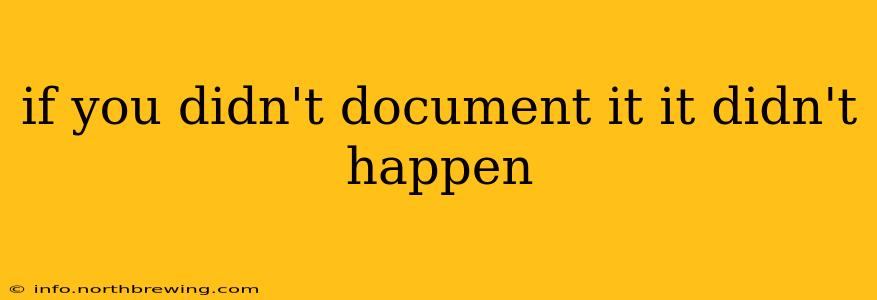In today's fast-paced world, the adage "If you didn't document it, it didn't happen" rings truer than ever. Across various fields, from software development and project management to healthcare and legal practices, meticulous documentation is no longer a suggestion; it's a necessity. This principle isn't about micromanagement; it's about accountability, efficiency, and protecting yourself and your organization from potential pitfalls. This post delves into why comprehensive documentation is paramount, exploring its benefits and offering practical tips for effective documentation strategies.
Why is Documentation So Important?
The core reason documentation is crucial is simple: memory is fallible. Even the most detail-oriented individual can't recall every nuance of a project, interaction, or process. Documentation provides an objective, verifiable record that transcends individual recollection. This is especially important when dealing with complex systems, intricate processes, or situations involving multiple stakeholders.
Without documentation, you risk:
- Missed deadlines and budget overruns: Lack of clear project specifications and progress tracking can lead to unforeseen delays and cost increases.
- Legal and compliance issues: In regulated industries, incomplete documentation can result in serious penalties.
- Reputational damage: Inconsistent service or product quality stemming from poor documentation can harm your reputation.
- Knowledge loss: When key personnel leave, crucial information can be lost if not properly documented.
- Inefficient workflows: Without clear procedures documented, teams can waste time recreating processes or making errors.
- Difficulty in troubleshooting and problem-solving: Tracing errors and finding solutions becomes significantly more challenging without detailed records.
What Types of Documentation Are Essential?
The specific types of documentation needed will vary depending on the context. However, some common forms include:
- Meeting minutes: Detailed records of discussions, decisions, and action items from meetings.
- Project plans: Comprehensive outlines of project goals, timelines, budgets, and responsibilities.
- Process documentation: Step-by-step guides on how to perform specific tasks or procedures.
- Technical documentation: Detailed descriptions of software, hardware, or other technical systems.
- User manuals: Instructions for users on how to operate equipment or software.
- Code comments: Explanatory notes within code that clarify functionality and logic.
- Incident reports: Records of unexpected events, malfunctions, or errors, including details of the event and steps taken to resolve it.
How to Improve Your Documentation Practices
Implementing effective documentation strategies requires a proactive and organized approach:
- Establish clear documentation standards: Define consistent formatting, terminology, and levels of detail.
- Use a centralized documentation system: Choose a platform that allows for easy access, collaboration, and version control. This could be a shared drive, a wiki, or a dedicated documentation management system.
- Make documentation a priority: Allocate dedicated time for documentation as part of your workflow.
- Train your team: Provide training on effective documentation techniques and the importance of accurate record-keeping.
- Regularly review and update documentation: Ensure that documentation remains current and accurate. Outdated information is worse than no information.
- Use clear and concise language: Avoid jargon and technical terms that may be confusing to those unfamiliar with the subject.
- Utilize visual aids: Charts, diagrams, and screenshots can greatly enhance understanding.
What are the Best Practices for Effective Documentation?
Effective documentation is more than just recording facts; it's about creating a resource that is easily accessible, understandable, and useful. Here are some key best practices:
- Use a consistent style guide: This ensures clarity and consistency throughout all your documents.
- Prioritize accuracy and completeness: Ensure all information is correct and comprehensive.
- Maintain version control: Track changes over time to prevent confusion.
- Regularly review and update: Keep your documents current and relevant.
- Make it searchable: Use clear headings, tags, and indexing to make information easily retrievable.
What are the consequences of poor documentation?
Poor documentation can lead to a multitude of problems, including:
- Wasted time and resources: Searching for information, recreating processes, or resolving issues due to a lack of clear records.
- Increased errors: Ambiguous instructions or incomplete documentation can lead to mistakes.
- Regulatory non-compliance: In regulated industries, poor documentation can lead to fines and legal action.
- Loss of intellectual property: Without proper documentation, valuable knowledge and expertise can be lost.
- Damage to reputation: Inconsistent service or product quality due to poor documentation can tarnish your brand image.
In conclusion, the simple yet profound principle of "If you didn't document it, it didn't happen" is not just a catchy phrase; it's a cornerstone of effective operations and risk management. By embracing a culture of comprehensive and meticulous documentation, organizations can significantly improve efficiency, reduce errors, and mitigate risks. Investing in robust documentation strategies is an investment in the long-term success and sustainability of any endeavor.
